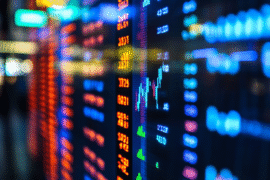This article may contain references to products or services from one or more of our advertisers or partners. We may receive compensation when you click on links to those products or services. Nonetheless, our opinions are our own.
The information presented in this article is accurate to the best of our knowledge at the time of publication. However, information is subject to change, and no guarantees are made about the continued accuracy or completeness of this content after its publication date.
Global Trends in High-Yield Savings Rates

As you review your personal finances and savings strategies, you may notice shifts in the high-yield savings account landscape. For years, these accounts have served as a dependable way to grow savings, offering interest rates well above traditional accounts and providing a safe, accessible option for conservative investors. Now, after a period of rising rates, the market is undergoing notable change, not due to financial crises, but as a result of broader economic adjustments and evolving banking policies.
The Legacy of High-Yield Accounts and Their Impact on Savers
High-yield savings accounts have long provided a valuable service, offering consumers the opportunity to earn meaningful interest while maintaining liquidity. For many savers, these accounts have represented more than just a financial product, they have symbolized stability, a tool for financial growth, and a means to build emergency funds or save for future goals. The importance of these accounts extends beyond individual balances; they contribute to overall financial wellness by promoting disciplined saving habits and encouraging community financial health. As this phase of rising interest rates begins to plateau or reverse, consider the legacy of high-yield accounts and what current trends signify for the future. These accounts have supported:
- Emergency Savings: Offering safe returns to keep funds accessible in times of need.
- Financial Inclusion: Providing opportunities for many to grow savings without complex investments.
- Consumer Confidence: Encouraging individuals to save rather than spend.
Maintaining awareness of how these accounts evolve is needed for all savers to undertake future opportunities and challenges in personal finance.
Reasons Behind Changing Interest Rates
The recent adjustments in high-yield savings account rates are often misunderstood. Many consumers may wonder why rates fluctuate and what drives these changes when accounts remain fundamentally sound. These shifts are generally influenced by several factors:
- Central Bank Policies: Interest rate decisions by central banks (such as the Federal Reserve, Bank of England, or Reserve Bank of Australia) directly impact the rates banks offer on savings accounts.
- Market Conditions: Inflation rates, economic growth forecasts, and financial market stability all play roles in shaping banking interest offerings.
- Bank Strategies: Financial institutions balance attracting deposits with lending and operational costs, leading to strategic rate adjustments.
- Competitive Landscape: Banks monitor competitors’ rates closely, and the proliferation of online banks often forces traditional banks to reconsider their offerings.
These factors empower you to make informed decisions about where and when to park your savings for optimal returns.
What These Changes Mean for Savers and the Economy
Fluctuations in high-yield savings account rates have meaningful consequences both for individual savers and the broader economy. For savers, rate reductions or slower growth in yields can affect financial goals, retirement planning, and emergency fund growth. Consider the following impacts:
- Lower Returns on Savings: Reduced interest earnings may require savers to increase contributions or explore alternative investments.
- Shift in Consumer Behavior: Savers may become more inclined to seek higher-risk, higher-return vehicles, potentially increasing exposure to market volatility.
- Economic Ripple Effects: Changes in savings rates influence consumer spending and borrowing behaviors, which in turn affect economic growth.
At the same time, the banking sector may experience shifts in deposit volumes and lending practices, prompting adjustments that affect the overall financial ecosystem.
Global Trends in High-Yield Savings Rates
As economic shifts impact retail and employment landscapes, staying informed about the broader financial environment is vital. One area attracting attention worldwide is the trend in high-yield savings rates, which directly affects how savers grow their funds in a changing market.
Australia
The Reserve Bank of Australia (RBA) recently reduced its official cash rate by 0.25%, lowering it to 3.85%. This reduction has caused a decline in term deposit rates, with some banks now offering rates below 5%. Financial experts suggest that savers consider diversifying into alternative investment vehicles such as bonds and shares to maintain healthy returns.
United Kingdom
Following a base rate cut by the Bank of England from 4.5% to 4.25%, leading banks, including HSBC and NatWest, have started adjusting savings account interest rates downward. For example, HSBC plans to reduce rates on several accounts, including its Online Bonus Saver, starting June 3, 2025.
United States
Despite some global declines, certain U.S. institutions continue to offer competitive high-yield savings rates. Banks like Varo Bank and Fitness Bank lead the market with Annual Percentage Yields (APYs) of 5.00%, while others, such as Axos Bank and OMB Bank, offer rates up to 4.66% APY. These attractive yields present opportunities for savers looking to maximize returns on liquid funds. These trends can empower you to make better financial decisions, especially in times of economic uncertainty triggered by events like the closure of long-standing retailers. Staying vigilant about interest rates and investment options helps protect and grow your savings.
How to Overcome the Changing High-Yield Savings
In light of these shifting tendencies, it is necessary that you modify your approach to investing your savings. Being proactive and informed can help you make the most of your money. Here are some considerations:
- Monitor Interest Rate Trends: Stay informed on central bank announcements and bank rate changes to identify the best times to open or move savings accounts.
- Compare Financial Products: Use online tools to compare APYs (Annual Percentage Yields), fees, and account terms across banks and credit unions.
- Diversify Savings Vehicles: Consider blending high-yield accounts with other low-risk investments like certificates of deposit (CDs), bonds, or money market funds.
- Plan for Inflation: Ensure your savings strategy accounts for inflation to maintain purchasing power over time.
Below is a simple table illustrating current average APYs and recommendations on when to consider switching or investing:
| Account Type | Average APY | Recommended Action |
|---|---|---|
| Online High-Yield Savings | 4.50% | Monitor and compare monthly |
| Traditional Savings | 0.10% | Consider moving funds |
| Certificates of Deposit | 4.00% | Ladder CDs for better yield |
By remaining vigilant and flexible, you can safeguard and potentially grow your savings despite market fluctuations.
Voted "Best Overall Budgeting App" by Forbes and WSJ
Monarch Money helps you budget, track spending, set goals, and plan your financial future—all in one app.
Get 50% OFF your first year with code MONARCHVIP
Tips for Maximizing Returns on Savings Accounts
Keep these tips in mind to optimize your returns:
- Read the Fine Print: Look out for minimum balance requirements, withdrawal limits, and fees that could affect your overall earnings.
- Take Advantage of Promotions: Some banks offer introductory bonuses or higher rates for new customers or deposits.
- Use Multiple Accounts: Spreading funds across accounts can help maximize interest and provide flexibility.
- Automate Savings: Set up automatic transfers to consistently build your balance and benefit from compound interest.
Here’s a checklist of actions to help you stay on track:
| Action | Purpose |
|---|---|
| Regularly review rates | Ensure your account remains competitive |
| Maintain required balances | Avoid fees that reduce returns |
| Track withdrawal limits | Preserve account status and interest |
| Explore credit unions | Often offer higher APYs |
Planning Your Financial Future Amid Shifting Savings Rates
The shifting environment of high-yield savings rates highlights the importance of ongoing financial planning. As rates rise or fall, reviewing your budget and investment strategies is prudent. Considerations include:
- Emergency Fund Adequacy: Ensure your emergency savings still meet your needs despite lower yields.
- Investment Diversification: Incorporate a mix of assets to balance risk and return.
- Long-Term Goals: Adjust savings goals and timelines in response to changing interest income.
- Stay Educated: Follow financial news and consult advisors if needed.
| Financial Focus | Recommended Step |
|---|---|
| Savings Growth | Increase contributions if yields decline |
| Investment Portfolio | Rebalance to reflect market conditions |
| Expense Management | Control spending to maintain savings rate |
By actively managing your finances, you position yourself to thrive regardless of interest rate cycles.
Conclusion
Globally, high-yield savings rates are being reshaped as central banks adjust monetary policy in response to inflation, employment trends, and economic forecasts. While these accounts still offer a more secure return compared to standard savings vehicles, their performance is increasingly influenced by macroeconomic conditions and competitive pressures within the banking industry.
Savers need to take a proactive, flexible approach to financial planning. Monitoring rate movements, diversifying savings products, and aligning strategies with long-term goals can help preserve purchasing power and strengthen financial resilience. Whether interest rates rise or fall, maintaining a dynamic and well-informed savings plan will ensure your money continues to work effectively in any market.
Ultimately, your strategy should strike a balance between stability, accessibility, and growth to meet the demands of an evolving financial future.
Frequently Asked Questions
What causes interest rates on high-yield savings accounts to change?
Rates primarily fluctuate due to central bank policies, economic conditions, and banks’ strategic decisions in balancing deposits and lending.
Are high-yield savings accounts still safe?
Yes, most high-yield accounts are insured by government agencies (like the FDIC in the U.S.), making them safe for your principal.
How can I find the best high-yield savings account?
Use comparison websites to check APYs, fees, and terms. Also, consider online banks and credit unions for competitive rates.
Do lower rates mean I should invest in riskier assets?
Not necessarily. While diversification is wise, risk tolerance and financial goals should guide investment choices.
Will the rates rise again soon?
Interest rates depend on economic conditions and central bank policies, which can change over time. Staying informed is necessary.

Reviewed and edited by Albert Fang.
See a typo or want to suggest an edit/revision to the content? Use the contact us form to provide feedback.
At FangWallet, we value editorial integrity and open collaboration in curating quality content for readers to enjoy. Much appreciated for the assist.
Did you like our article and find it insightful? We encourage sharing the article link with family and friends to benefit as well - better yet, sharing on social media. Thank you for the support! 🍉
Article Title: Global High-yield Savings Trends for 2025
https://fangwallet.com/2025/08/13/global-high-yield-savings-trends-for-2025/The FangWallet Promise
FangWallet is an editorially independent resource - founded on breaking down challenging financial concepts for anyone to understand since 2014. While we adhere to editorial integrity, note that this post may contain references to products from our partners.
The FangWallet promise is always to have your best interest in mind and be transparent and honest about the financial picture.
Become an Insider

Subscribe to get a free daily budget planner printable to help get your money on track!
Make passive money the right way. No spam.
Editorial Disclaimer: The editorial content on this page is not provided by any of the companies mentioned. The opinions expressed here are the author's alone.
The content of this website is for informational purposes only and does not represent investment advice, or an offer or solicitation to buy or sell any security, investment, or product. Investors are encouraged to do their own due diligence, and, if necessary, consult professional advising before making any investment decisions. Investing involves a high degree of risk, and financial losses may occur including the potential loss of principal.
Source Citation References:
+ Inspo
Investopedia. (2025, May). Best high-yield savings account rates for May 2025.













































